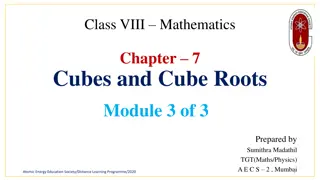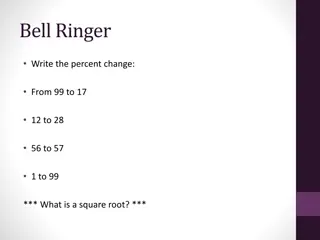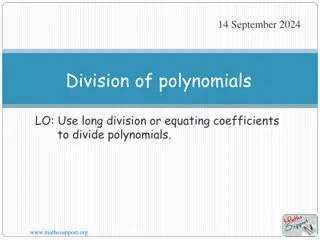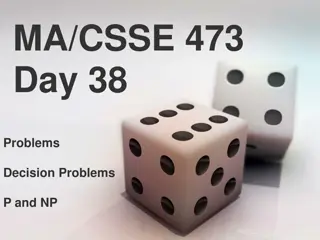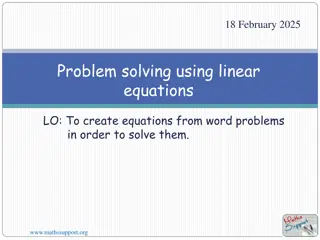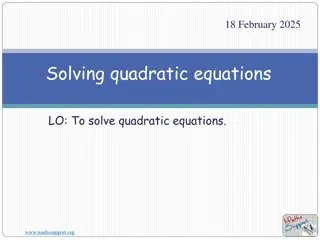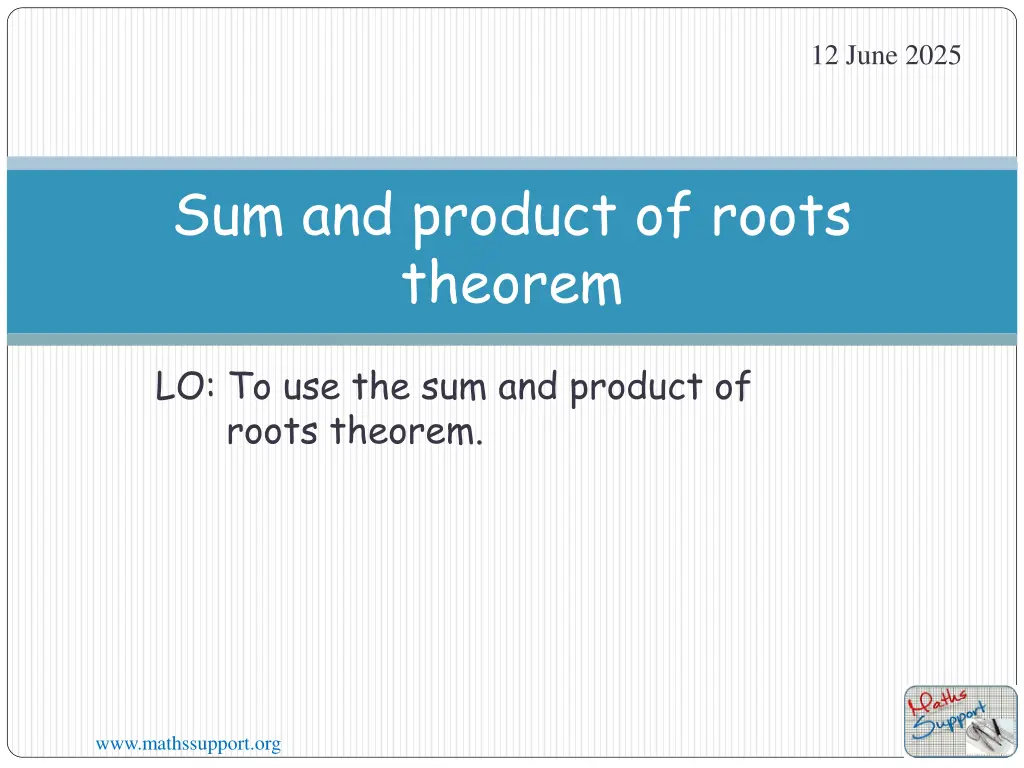
Understanding the Sum and Product of Roots Theorem in Polynomial Equations
Learn how to use the sum and product of roots theorem in quadratic, cubic, and higher-degree polynomial equations. Discover formulas for finding the sum and product of roots in different polynomial degrees and explore examples to deepen your understanding.
Download Presentation

Please find below an Image/Link to download the presentation.
The content on the website is provided AS IS for your information and personal use only. It may not be sold, licensed, or shared on other websites without obtaining consent from the author. If you encounter any issues during the download, it is possible that the publisher has removed the file from their server.
You are allowed to download the files provided on this website for personal or commercial use, subject to the condition that they are used lawfully. All files are the property of their respective owners.
The content on the website is provided AS IS for your information and personal use only. It may not be sold, licensed, or shared on other websites without obtaining consent from the author.
E N D
Presentation Transcript
12 June 2025 Sum and product of roots theorem LO: To use the sum and product of roots theorem. www.mathssupport.org
Sum and product of roots. We have seen that for the quadratic equation a,b,c and a 0 The sum of the roots x1+ x2 is And the product of the roots x1x2 is Find the zeros of this equations: x2 + 6x + 5 = 0 ax2 + bx + c = 0 ? ? ? ? 2x2 3x + 4 = 0 x2 4x + 5 = 0 Find the sum and the product of their roots www.mathssupport.org
Polynomials of third degree. Given a cubic equation ax3 + bx2 + cx + d = 0 and x1,x2 and x3 are the solutions We can factorise the cubic polynomial f(x) = ax3 + bx2 + cx + d = a(x x1) (x x2)(x x3) x3 + ? Expanding the right hand side of the equation [x2 x2x x1x+ x1x2](x x3) x3 x2x2 x1x2 + x1x2x x3x2 + x2x3x+ x1x3x x1x2 x3) x3 x1x2 x2x2 x3x2 + x1x2x + x1x3x+ x2x3x x1x2 x3 ] [ a,b,c,d and a 0 [ ] ? x2 + ? ? x + ? ? = (x x1) (x x2)(x x3) Dividing by a Expanding the first two brackets Multiplying out the third bracket Put the terms in order Grouping[ (x1 + x2 + x3)x2 ] + (x1x2 + x1x3+ x2x3)x x1x2 x3 x3 www.mathssupport.org
Polynomials of third grade. x3 + ? ? x2 + ? ? x + ? ? = x3 (x1+x2+x3)x2 + (x1x2+x1x3+x2x3)x x1x2 x3 =? ? =? ? =? ? These are Vi te s formulae for cubic equations. Find a similar formulae that satisfy the relationship between the zeros and the coefficients of a quartic polynomial. ax4 + bx3 + cx2 + dx + e = 0 = ? (x1+x2+x3) (x1+x2+x3) ? =? (x1x2+x1x3+x2x3) (x1x2+x1x3+x2x3) ? = ? (x1x2 x3) (x1x2 x3) ? a,b,c,d, e and a 0 www.mathssupport.org
Polynomials of the nth degree. Given a polynomial f(x) = anxn+an-1xn-1+an-2xn-2+ +a2x2 + a1x + a0 With real or complex coefficients (an 0 ) and zeros x1,x2 xn then = ?? 1 x1+x2+x3+ +xn ?? =?? 2 ?? (x1x2+x1x3+ +x1xn+ x2x3+ x2x4+ +x2xn+ xn-1xn . . . = 1??0 x1x2 x3 xn ?? ?? 1 ?? 1??0 The sum of all the roots x1+ x2+ + xnis And the product of the roots x1x2 xnis ?? www.mathssupport.org
Polynomials of the nth degree. Example 1: Find the sum and product of the zeros of these polynomial. f(x) = x4 3x3 + 11x2 + 17x 4 For a polynomial of degree n you need to use: an, an-1 and a0 x1+x2+x3+x4= ?? 1 = 3 n = 4 = 3 ?? 1 an = a4 = 1 an-1 = a3 = 3 = 1??0 = 14 4 x1x2 x3x4 a0 = 4 = 4 ?? 1 www.mathssupport.org
Polynomials of the nth degree. Example 2: Find the sum and product of the zeros of these polynomial. f(x) = 3x5+ 11x4 4x3 + 5x2 13x +9 For a polynomial of degree n you need to use: an, an-1 and a0 x1+x2+x3+x4+x5= ?? 1 = 11 n = 5 ?? 3 an = a5 = 3 an-1 = a4 = 11 x1x2 x3x4 x5 = 1??0 ??= 159 a0 = 9 = 3 3 www.mathssupport.org
Polynomials of the nth degree. Example 3: Find a quadratic whose roots are Let the desired quadratic be x2 + bx + c, where we wish to find b and c. Then Viete's formula tells us 3 + 2i and 3 2i. n = 2 x1+x2 = ?? 1 = ? 3 2i = b = 3 + 2i b = 6 b = 6 + an = a2 = 1 an-1 = a1 = ? ?? 1 a0 = ? = 12? x1x2 = 1??0 (3 2i) =c = (3 + 2i) c x1 = 3 + 2i x2 = 3 2i 1 ?? = 13 So the desired quadratic is x2 6x + 13 www.mathssupport.org
Polynomials of the nth degree. Example 4: Find a cubic polynomial with integer coefficients whose roots are -1, 2 and p, given that the sum of the roots is 4. n = 3 an = 1 an-1 = ? a0 = ? a Let s choose a = 1 to get the simplest polynomial with integer coefficients: x1+ x2 + x3 = ?? 1 -1 + 2+ p = 4 p = 3 So, the polynomial is: (x + 1)(x 2)(x 3) = = 4 ?? The roots are: 1, 2, 3 x1 = -1 x2 = 2 x3 = p (x 3) (x 2) Now expand = (x + 1) x3 4x2 + x + 6 So the desired cubic is www.mathssupport.org
Polynomials of the nth degree. Example 5: If the sum of the reciprocals of the roots of the quadratic 3x2+7x + k = 0 is 7 x1and x2are the roots 1 ?1 and 1 x2 1 ?1 + 1 x2 1 ?1 + 1 x2 3 ?1+ x2 ?1x2 = 7 3 = 3 k 3. What is k? are the reciprocals of the roots is the sum of the reciprocals of the roots 7 3 ? 3 = ?? 1 = 7 x1+x2 =7 =7 ?? 3 3 = 1??0 = 12? 3=? x1x2 21 3?=7 ?? 3 3 www.mathssupport.org
Thank you for using resources from A close up of a cage Description automatically generated For more resources visit our website https://www.mathssupport.org If you have a special request, drop us an email info@mathssupport.org www.mathssupport.org




